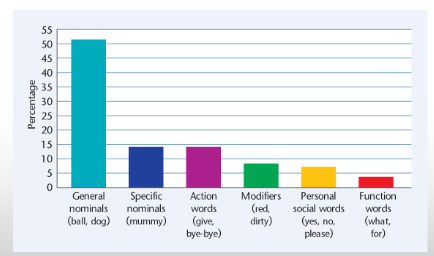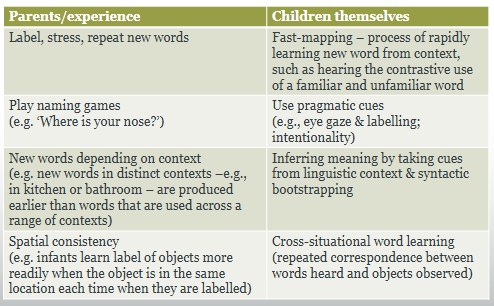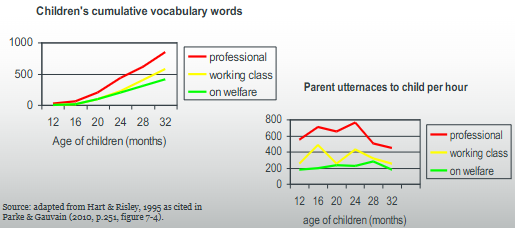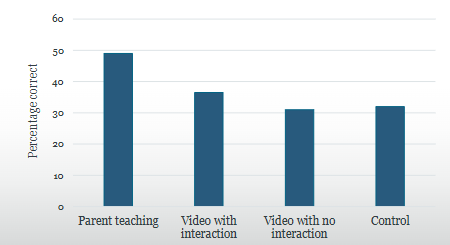Language Development
1/50
Earn XP
Description and Tags
WEEK PSYC 2007
Name | Mastery | Learn | Test | Matching | Spaced |
|---|
No study sessions yet.
51 Terms
Challenge of Language Learning
Saffran, J.R., Senghaus, A., Trueswell, J.C. (2001)
Must discover the internal structure of a system that contains tens of thousands of units [words], all generated from a small set of materials [sounds], which can be assembled into an infinite number of combinations [sentences].
What does Language Development Require?
Comprehension
Production
Components of Language
Components of Language
Phonology – system of sounds (phonemes, e.g. “b” vs.“d”)
Semantics – meanings of words and combinations
Grammar – structure of language (arranging words into sentences)
Pragmatics – social rules for language (context use, turn taking etc.)
Effective social communication
Theories of language development
Learning
Interactionist
Nativist
Learning Perspective Theorist
Skinner
Bandura
Learning / Empiricist perspective- Skinner
Children are reinforced with grammatically correct speech.
Adults “shape” child’s speech by selectively reinforcing babbling that sounds most like words.
Once words have been shaped, reinforcement (e.g., attention) is withheld until child begins to combine words.
Social learning theorists—Bandura 1971
Children listen + imitate language of older companions.
Caregivers “teach” language by modelling language.
Nativist Perspective Theorist
Chomsky- LAD
Dan Slobin- LMC
Nativist Perspective
Biologically Programmed to acquire language.
LAD (Language aquistion device)- universal grammar
LMC( language-making capacity)
Children have an inborn language-making capacity (LMC)
Dan Slobin (1985)
A set of cognitive/perceptual abilities highly specialised for language learning.
Interactionist perspective
Complex interplay between biological maturation, cognitive development, and the linguistic environment.
Universal- children across the world develop language at
a similar pace
Members of the same species/share many experiences
Children are biologically prepared to learn language (not because of LAD/LMC), but because they have a powerful brain that slowly matures/gives children more to talk about.
Language develops as children communicate with other people.
What Part of the Brain Facilitates Language Development?
Left Hemisphere
Damage leads to aphasia→
Broca’s area: affects speech production
Wernicke’s area: affects comprehension
Sensitive Periods
Case study of Genie
Prelinguistic Phase
• Infants start to process sounds in the womb (DeCasper & Spence, 1986)
infants preferred to listen to the intonation of the passages they had been exposed to prenatally
1 – 2m: infants discriminate between different phonemes.
Werker & Tees (2005) - Prelinguistic Phase
Discrimination includes speech sounds across different
languages; that decreases at 6-12 months; “neural
commitment”
Speech Production Beginnings
Different patterns of crying (hunger, anger, pain)- increasingly social in nature.
1 month- begin to coo
Repitive vowel sounds signal pleasure/ vary in volume + pitch.
(Bateson, 1975)- Proto-conversations
Mothers tend to vocalise when their infants have finished vocalising, which simulates turn-taking
Evolve into triadic interactions when infants point to objects
Proto-imperative - requests for objects/actions
Proto-declarative- comments on objects or actions
Speech Production Development
1 Month- cooing and laughing
4-6 Months- Babbling/vocal lay
6-10 Months- Conical Babbling
Babbling repetitive vowel-consonant combinations
Gradually develop intonation
Shift to sounds that are heard most (combinations of sounds that sound like words).
Receptive Language
Understanding Language(words)
Evident before expressive language
Fenson (1994)- mother’s report of # words understood by infant:
10 M- 30 words
13 M- 100 words
(Bergelson & Swingley, 2012): Infants begin associating highly familiar words with highly familiar referents early
Most parents do not realize
6-9 M- infants knew meaning of common nouns
Learning is constraint
‘Whole object constraint’/ ‘Mutual exclusivity constraint’
1st words
10- 15 months
used consistently in presence of object/situation- i.e “oof'“ for all food
Condense meaning
Holophrase period: 12-18 months – a whole phrase (i.e. a whole idea) with a single word (e.g. “ba” for “I want the ball”).
Overextension: one word is applied in a broader context than is appropriate (e.g., ‘doggy’ for all four-legged animals, or ‘apple’ for all kinds of fruit).
Vocabulary spurt: 16-24 months
What kinds of words are leardened first?
Percent of first 50 words in a given category (Nelson, 1973)

VOCAB SPURT—PARENT FACILITATION
Label, stress, repeat new words
Name Games- e.g where is your nose
New words depending on context (e.g. new words in distinct contexts –e.g., in kitchen or bathroom – are produced earlier than words that are used across a range of contexts).
Spatial consistency (e.g. infants learn label of objects more readily when the object is in the same location each time when they are labelled).
VOCAB SPURT—CHILD FACILITATION
Fast-mapping- process of rapidly learning new word from context, such as hearing the contrastive use of a familiar and unfamiliar word.
Pragmatic cues- (e.g., eye gaze & labelling; intentionality)
Inferring meaning-taking cues from linguistic context/syntactic bootstrapping.
Cross-situational word learning (repeated correspondence between words heard and objects observed)
Facilitators of vocabulary spurt

First Sentences
18- 24 months- Combining two words
Telegraphic Speech
Short/simple
Missing grammatical markers
Reflect multiple meanings depending on context
I.E- “Ben shoe” = “That is Ben’s shoe” or “Put on my
shoe”
2 – 3 years: Development of Grammar
Telegraphic speech ceases
Add inflections- ‘ing’;‘s’
Form questions - (“What daddy eat?” -“What is daddy eating?”)
Form negatives - (“No mitten” - ”I won’t wear my mittens”).
Children create forms that they have not heard but follow their current understanding of grammar.
3-4 years: Development of Grammar
Overregularization
Apply basic rules to irregular words - “ed”
Form more complex sentences
Conjunctions (‘and’; ‘but’) to connect words
Embedded clauses- (,)
Development of Grammar
(Fenson et al., 1994)- Very strong correlation between vocabulary size and complexity of a child’s sentences.
Major strides in grammar use between ages 1-4 years.
> 4 years: further refinements
Hart & Risley (1995)
Social class and vocabulary development
Differences in children’s vocabulary size and the frequencies with which parents talk to their children dependent on social class.
Higher for professional class vs the welfare class

DeLoache et al. (2010)
Technology and language learning
Infants who learn from their parents performed best in word
learning.
Infants in the two video-learning conditions did not perform significantly better than the control group.

The Newport and Johnson (1989) study suggests which of the following are true?
The ability to learn languages declines after children reach the age of approximately 7.
Before the age of 7, children can learn a second language with similar proficiency to native speakers.
Which of the following are associated with the nativist perspective on language acquisition?
Language acquisition device
The role of nature in language acquisition
Critical periods
Universal grammar
Amy consistently refers to all forms of transport as "car". This is an example of:
Overextension
Which of the following are examples of child-directed speech?
Melodic speaking style
Exaggerated facial expressions
Repetition
High pitched voice
Simple words and phrase
Which of the following phrases would be typical of the holophrase period?
"ball" instead of "I want the ball"
"gone" instead of "daddy has gone"
"Whole object constraint" refers to the idea that
Children expect that a word will always refer to a whole object.
Which of the following are examples of telegraphic speech?
"Mummy sleep"
"Want ball"
What is over-regulisation?
Applying the basic rules of language to irregular words
What is 'overextension' in the context of language development?
One word is applied in a broader context than is appropriate.
In Nelson’s study (1973), what kind of words dominate the first 50 spoken by children?
Object labels (nouns)
Who studied speech perception by having women who were 7.5 months pregnant read stories twice a day?
DeCasper and Spence (1986)
What did DeLoache et al. (2010) conclude about language acquisition?
Parents teaching children led to more language acquisition than video.
According to Johnson and Newcomb (2009), at what age did learning age stop having a positive effect on English proficiency test scores?
7 years
What is fast mapping?
Quickly linking new words to meaning after minimal exposure
Which phenomenon is shown by “goed” or “runned”?
Overregularisation
Which part of the brain is most related to speech production?
Broca’s area
What is “mutual exclusivity” in word learning?
Children assume a new word refers to an unfamiliar object
Pragmatics
how context influences meaning and how language is used in social situations
Social rules like turn-taking and context use.
Werker & Tees (2005) found that children's ability to discriminate between different language sounds decreased at _____ months because of neural commitment. This is a characteristic of the prelinguistic phase.
12-16 months